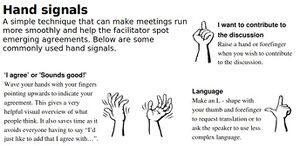Meeting culture: Difference between revisions
"migration of handbook pages from https://git.kanthaus.online/kanthaus/handbook" |
Add "Setting" section |
||
| (10 intermediate revisions by 3 users not shown) | |||
| Line 1: | Line 1: | ||
👥 We want to be efficient and respectful of peoples' time. We acknowledge the fact that in-person meetings are not the best format for all kinds of work and try to be accessible also to people who are physically distant. | |||
== Timing == | |||
We set clear starting and ending times for our collective meetings: [[CoMe]], [[PlaMe]], [[Social sauna]] & Project Updates. We ask attendees to be on time, which means being a little bit early. It can be nice to announce that a meeting is starting soon, but time-keeping is seen ultimately as an individual responsibility. Always feel empowered to start on time. | |||
Everyone is late sometimes. If it is still worth attending, try to reduce disturbance. It is not necessary to apologize. Be aware that things have been said already and people may not wish to repeat them. | |||
We expect meetings to end at the time set initially. Extensions are possible, but should be proposed and consented in the meeting. | |||
== Setting == | |||
We take care to hold meetings in a way that allows everyone to focus. Time and place should be considered to avoid possible disturbance from and to non-participants. Participants are encouraged to be mindful of noise and movement they make that might disturb others, and take reasonable measures to reduce their impact: while eating is allowed, please avoid crunchy food, food preparation or using metal cutlery with porcelain; if fidgeting is helpful for you, find something that can be fidgeted silently before the meeting starts. | |||
== Hand signals == | == Hand signals == | ||
[[File:HandSignals.jpg|thumb]]To make it possible to give silent feedback we use [https://www.collaborationsuperpowers.com/wp-content/uploads/2020/04/Handout-Hand-signals-for-remote-meeting-facilitation.pdf hand signals]. Their use is to ‘comment’ without disrupting the speaker. We mostly just use: | |||
* 🙌 raised & wiggling ("jazz") hands: agree, sounds good, etc | |||
* ✋ raised hand: I want to speak (next) | |||
* '''T''' "t-shape": technical point (speaker volume, time, language, etc) | |||
Additional to the list above we sometimes use the so-called ‘temperature check’ to get an understanding of the feeling of the group towards a certain issue. To achieve that one person asks the group for said temperature check and then everybody wiggles their hands either downward (cold, no support, maybe even resistance), upward (hot, big support, enthusiasm) or somewhere in the middle. | |||
== Pads == | == Pads == | ||
Our main meetings (like [[ | Our main meetings (like [[CoMe]] or [[PlaMe]]) usually are backed up by corresponding online pads which contain the procedure and topics visible and editable for everyone. This means that people often bring laptops or phones to follow what’s going on. Facilitators in turn usually don’t readout everything or explain the format in the beginning, since it’s technically available already. | ||
[[Category:Social]] | |||
[[Category:Digital]] | |||
Latest revision as of 17:59, 26 November 2025
👥 We want to be efficient and respectful of peoples' time. We acknowledge the fact that in-person meetings are not the best format for all kinds of work and try to be accessible also to people who are physically distant.
Timing
We set clear starting and ending times for our collective meetings: CoMe, PlaMe, Social sauna & Project Updates. We ask attendees to be on time, which means being a little bit early. It can be nice to announce that a meeting is starting soon, but time-keeping is seen ultimately as an individual responsibility. Always feel empowered to start on time.
Everyone is late sometimes. If it is still worth attending, try to reduce disturbance. It is not necessary to apologize. Be aware that things have been said already and people may not wish to repeat them.
We expect meetings to end at the time set initially. Extensions are possible, but should be proposed and consented in the meeting.
Setting
We take care to hold meetings in a way that allows everyone to focus. Time and place should be considered to avoid possible disturbance from and to non-participants. Participants are encouraged to be mindful of noise and movement they make that might disturb others, and take reasonable measures to reduce their impact: while eating is allowed, please avoid crunchy food, food preparation or using metal cutlery with porcelain; if fidgeting is helpful for you, find something that can be fidgeted silently before the meeting starts.
Hand signals

To make it possible to give silent feedback we use hand signals. Their use is to ‘comment’ without disrupting the speaker. We mostly just use:
- 🙌 raised & wiggling ("jazz") hands: agree, sounds good, etc
- ✋ raised hand: I want to speak (next)
- T "t-shape": technical point (speaker volume, time, language, etc)
Additional to the list above we sometimes use the so-called ‘temperature check’ to get an understanding of the feeling of the group towards a certain issue. To achieve that one person asks the group for said temperature check and then everybody wiggles their hands either downward (cold, no support, maybe even resistance), upward (hot, big support, enthusiasm) or somewhere in the middle.
Pads
Our main meetings (like CoMe or PlaMe) usually are backed up by corresponding online pads which contain the procedure and topics visible and editable for everyone. This means that people often bring laptops or phones to follow what’s going on. Facilitators in turn usually don’t readout everything or explain the format in the beginning, since it’s technically available already.